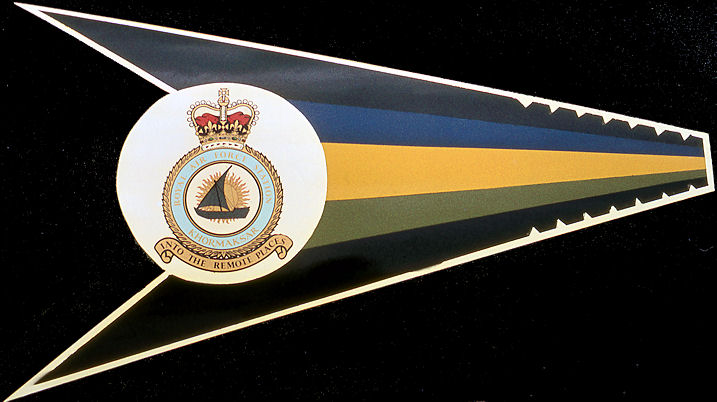|
|

|
|
Peter's 'own' FR.10, XE614/PL, cruises up to the camera aircraft during a sortie from Khormaksar in 1964 (Peter Lewis)
After 20 years service with the Republic of Singapore Air Force, XE614 was preserved and is currently on static display at the Queensland Aviation Museum in Australia. |
|

|
|
One of the most prodigious strikes carried out by the Khormaksar Hunter Wing was the dawn attack on Fort Harib in the Yemen on 28-03-64 (Peter Lewis)
This pre-strike image depicts the Fort shortly before it was hit by HE cannon and rocket fire from eight FGA.9s of 8 and 43 Squadrons and was taken from Peter's FR.10 (XE614). |
|

|
|
Despite its solid stone-built construction, this post-strike view of Fort Harib confirmed its destruction (Peter Lewis)
|
|

|
|
Typical of the stone-built houses, this one is perched on top of a steep precipice, deep in the heart of the Radfan mountains (Peter Lewis)
|
|

|
|
All that remains of a house in the Radfan following an attack by Strike Wing Hunters (Peter Lewis)
|
|
|
|
.jpg)
|
|
A regular task for the Strike Wing Hunters, protecting Army convoys along the Dhala road. (Peter Lewis)
Troops give Peter a wave while giving their 3-ton Bedfords a break |
|

|
|
Another Army convoy that enjoyed the protection of the Hunter force is seen on route to Beihan complete with recovery truck (Peter Lewis)
|
|

|
|
The journey to Beihan was not all open desert. Here, a Scout car follows a recovery truck as it rumbles through a bushy area (Peter Lewis)
|
|
.jpg)
|
|
One of the most scenic settings in the Hadramaut area of the EAP was the town of Saiwan, depicted here and in the following two images (Peter Lewis)
|
|
.jpg)
|
|
The main part of Saiwan captured on one of Peter's FR.10 nose cameras (Peter Lewis)
|
|
|
|
.jpg)
|
|
Despite its arid look, the Hadramaut enjoyed sufficient rain to sustain crops and fruit plantations (Peter Lewis)
|
|

|
|
The Hunters exercised regularly with RN ships during which, images such as this one of HMS Centaur in 1964, were captured (Peter Lewis)
|
|

|
|
Eastern Block spy vessels were a constant menace and continually monitored by Khormaksar-based Hunters and Shackletons (Peter Lewis)
This one is the Sinoutskerk and was caught by Peter's FR.10 lurking in the Gulf of Aden. |
|

|
|
Up at the crack of dawn on an Operation Ranji sortie enabled Peter captured images such as this beautiful sunrise over the Gulf of Aden (Peter Lewis)
|
|

|
|
Operation Ranji. This involved flying sweeps of the coast looking for ‘gun runners’ landing weaponry for insurgents inland (Peter Lewis)
Arab Dhows, such as this one off the coast of Aden, were commonly used to land arms ashore. |
|
|
|

|
|
Operation Ranji. Once ashore, the arms were loaded on to a truck (or camel) and driven off along the beach ..... (Peter Lewis)
|
|

|
|
..... or inland to some up country destination (Peter Lewis)
|
|

|
|
Operation Ranji. Four suspicious looking trucks are captured cooling off while on a long drive across the desert (Peter Lewis)
|
|

|
|
Operation Ranji. As camels were often used to ship arms from the coast to the mountains, they were photographed when spotted (Peter Lewis)
This scene was taken over a well at Am Makhnuk |
|

|
|
Operation Ranji. Several camels and donkeys can be seen in this view of a well at Aldiyan (Peter Lewis)
|
|
|
|

|
|
Commonly known as the 'Empty Quarter' the Lodar Plain was one place pilots feared of having to eject (Peter Lewis)
|
|

|
|
A broad variety of objects were selected as targets for training purposes: this one being at Mafhid ..... (Peter Lewis)
|
|

|
|
..... while this one was a watch tower in Wadi Ruqub before it had received attention from the Hunters (Peter Lewis)
|
|

|
|
This intact watch tower, standing on a promontory in Wadi Ruqub, made an ideal reference point for pilots flying low through the area (Peter Lewis)
|
|

|
|
Peter 'snapped' this image of a village nestling at the foot of the mountains while flying further along Wadi Ruqub (Peter Lewis)
|
|
|
|

|
|
Good judgement was required by low flying Hunter pilots as they approached this wall of rock at the head of Wadi Ruqub (Peter Lewis)
|
|

|
|
The occupants of this tiny settlement north west of Ras Imram obviously preferred the isolation of this hot desert plain (Peter Lewis)
|
|

|
|
This group of houses was located some eight miles east of Al Mafhid (Peter Lewis)
|
|
.jpg)
|
|
Peter manoeuvres his FR.10 into position to take a series of photographs of the town of Al Mafhid (Peter Lewis)
|
|

|
|
Flying low over the centre of Al Mafhid, the F95 camera captured this excellent image of this assortment of houses styles ..... (Peter Lewis)
|
|
|
|

|
|
..... before moving on to a fruit plantation on the edge of the town (Peter Lewis)
|
|
|

